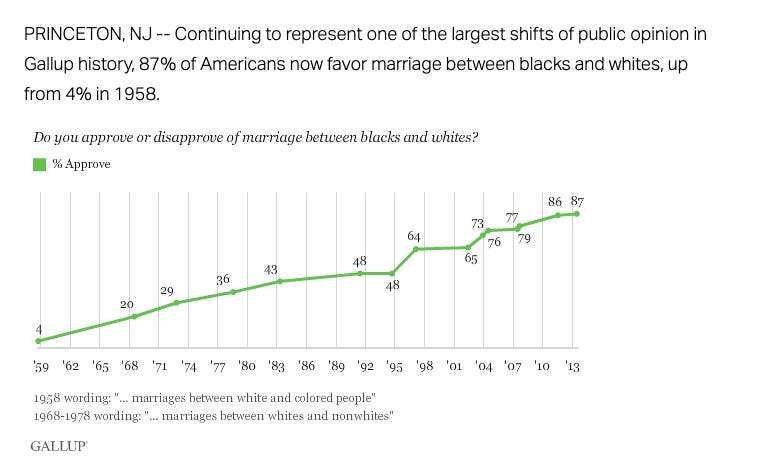Wall Street, the New Deal and Jim Crow

Wall Street, the New Deal and Jim Crow
Matt Stoller
William Levitt was the creator of the modern post-WWII suburb, and in many ways, his thinking illustrated how we chose to structure a key part of the long New Deal era, in the form of the American home. Two quotes illustrate his views. First, he argued for homeownership as an important instrument in social order. “No man who owns his own house and lot can be a communist,” he said. “He has too much to do.” In other words, a working person with a stake in society takes seriously their obligation to society, whereas someone with no stake has nothing to lose and turns radical.
The 1940s through the 1970s was a time when Wall Street had lost its power and relevance, and the American economic order was a diversified mix of manufacturing, agriculture, services, social welfare, military equipment, research, and high-technology. The collapse of financiers and monopolists was epitomized by the public financing of housing stock that enabled Levitt to build what he did. America had an increasingly empowered middle and working class.
And yet, this era co-existed with a fascist Jim Crow regime in the South enforced by vigilante terrorism against the black population, especially black leaders who were economically empowered. There was wide and broad cultural support for segregation, though not the specific violent tactics used to uphold such an order. As an example, just 4% of Americans in 1958 approved of black-white interracial marriage.
Segregation in the North was almost as bad as it was in the south, but was organized through economic arrangements, not public Jim Crow statutes but private contract law. Levitt, whose first suburbs were in the North, believed that racial segregation was a necessary mechanism to address the serious housing shortage Americans confronted. "We can solve a housing problem, or we can try to solve a racial problem,” Levitt argued. “But we can't combine the two."
There was a massive housing shortage immediately after World War II, because America essentially hadn’t built any housing stock since 1933. Levitt was a businessman, but he refused to integrate his housing developments racially, and had white-only covenants which made it impossible for black people to buy into his suburbs. Broadly speaking, Levitt was reflecting the social consensus of the era.
While bigotry was a widely held cultural attitude, racism as an institutional phenomenon was buried in every nook and cranny of the American order. It was not just police violence, Jim Crow laws, or the subtext of vigilante racial terrorism, though those were the most obvious signposts. There were serious disparities in health care treatment, access to capital, auto insurance, business insurance, patent law, hiring decisions, housing, media ownership, transportation, education and nutrition options, not to mention the endless number of opportunities closed off because of segregated social networks. Most of these disparities still exist. Even today, with an increasingly wealthy number of black businesspeople, monopolists like Comcast undermine the ability of black business leaders to operate as independent sellers of content.
Throughout American history, racism and corporate power have intersected in a variety of important ways. Sometimes our market structures have aided the struggle for racial liberation, sometimes they've impeded it, and oftentimes racial backlash has been used as a pretext to implement autocratic economic policies. There are moments when economic inequality comes wrapped in the language of justice, and moments when those who seek broad economic equality diminish the importance of racial discrimination. The relationship between corporate power and racism is not simple.
So to look at the post-war suburban creation as purely a moment of monstrous and publicly sanctioned racism is to miss that the Jim Crow order was weakening because of some of the same trends propelling Levitt’s success. Jim Crow, as I’ve written, was a *deal* between Northern monopolists and Southern whites, and it was both social and economic in orientation.
Attacks in the 1930s on financiers undermined racial segregation by replacing monopolists with public institutions responsive to a broad middle class. FDR in the 1930s made fun of Virginia Senator Harry Byrd, a segregationist Democrat who had grown wealthy growing apples. In one instance where Byrd opposed a program to put Americans to work, FDR told a subordinate Rex Tugwell, “I know what's the matter with Byrd, he's afraid you'll force him to pay more than ten cents for his apple pickers." Roosevelt did not attack segregation directly, but he did attack its economic roots. The Civil Rights movement then built on top of the political structure Roosevelt created. Political leaders, and black and white activists, sought the same economic and political empowerment for blacks that the New Deal had offered to whites.
The narrative of Jim Crow as an economic deal was first characterized in rigorous scholarly detail by W.E.B. Dubois in the 1930s in Black Reconstruction, and then reiterated by C. Vann Woodward in the The Strange Career of Jim Crow. There’s been a lot of critical and important scholarship advancing and critiquing these ideas, but Martin Luther King Jr. called Woodward’s book the “the historical Bible of the civil rights movement.” At Selma in 1965, MLK said the following.
If it may be said of the slavery era that the white man took the world and gave the Negro Jesus, then it may be said of the Reconstruction era that the southern aristocracy took the world and gave the poor white man Jim Crow. He gave him Jim Crow. And when his wrinkled stomach cried out for the food that his empty pockets could not provide, he ate Jim Crow, a psychological bird that told him that no matter how bad off he was, at least he was a white man, better than the black man. And he ate Jim Crow. And when his undernourished children cried out for the necessities that his low wages could not provide, he showed them the Jim Crow signs on the buses and in the stores, on the streets and in the public buildings. And his children, too, learned to feed upon Jim Crow, their last outpost of psychological oblivion.
By the time MLK spoke these words, the collapse of Jim Crow was evident. Woodward dubbed the post-war era a “Second Reconstruction,” analogizing it to the hopeful period after the Civil War when America had a brief chance to forge a racially egalitarian nation.
In the 1950s and 1960s, racial terrorism existed, lynchings were common, and racism was open and brutal, but gone were the days of the 1920s, when the Democratic Party feuded over whether to openly align with the Ku Klux Klan, which was then so powerful it could elect Governors and Senators all over the country. From the 1940s onward, blacks were moving out of the South due to a low unemployment rate organized by New Deal economists, and income among blacks rose at roughly twice the rate as whites for decades, albeit from a much lower base. Lifespans too closed a yawing gap.
America did chip away at these immoral racial disparities, slowly and incompletely, until the late 1960s. We used politics in the 1930s to restore economic liberties to citizens, and then we gradually broadened the scope of who could be a citizen. It is easy to sound callous in making this observation; someone killed by racial violence in the 1960s never got to experience the improved circumstances. Broadly, though, circumstances for lot of people began getting better, though not quickly enough.
And then came the 1970s, and the attack on racial egalitarianism. This was framed not as attacking the idea of racial equality, but on its economic underpinning, the New Deal. As Judith Stein observed in Pivotal Decade: How the United States Traded Factories for Finance in the Seventies as well as Running Steel, Running America, policymakers like Paul Volcker, Jimmy Carter, and William Simon chose to trade away increasing chunks of the middle class through offshoring jobs for geopolitical purposes. There were legitimate problems with the New Deal order, such as bad regulations, a loosening financial order, and gruesome errors like the Vietnam War, so change was coming regardless. But the change we sought was to elevate the political power of financial middlemen, and downgrade the political power of workers, farmers, engineers, and businesspeople.
As Stein chronicled, this was most evident in the deindustrialization of unionized heavy industry. Offshoring steel and automobile production had a special role in fueling racial tensions. White workers usually had a longer tenure of work, and according to union rules would be the last laid off because of this tenure. So offshoring would cause black layoffs first, and then white layoffs. Civil rights groups rightfully understood that as racist, but few recognized the largest context that racial tension was a result of white and black workers feuding over a smaller and smaller pie.
In my research, what I found is that an increasingly upscale neoliberal Republican and Democratic Party elite were oblivious to the underlying dynamics at play. The New Right, led by Ronald Reagan, was animated by racial backlash politics and social conservatives, as well as a goal of rolling back the New Deal order of constraining corporate power. Still, Robert Bork, an intellectual leader of the Reagan revolution, never achieved the conservative popular culture he wanted, but he did end antitrust law and public constraints on financiers.
The left, meanwhile, did not understand that the Civil Rights movement was built on top of the New Deal, and many were obsessed with New Age rhetoric, elite technocracy, and consumer and environmental politics. Futurist Alvin Toffler talked of getting rid of that “old New Deal clap-trap” and was a constant presence at Democratic party convenings in the mid-1970s, as well as an advisor to Al Gore. Michael Milken, the godfather of private equity, used countercultural rhetoric in his justification for financial power, saying in the 1970s, “Unlike other crusaders from Berkeley, I have chosen Wall Street as my battleground for improving society.” (He’s still at it today, pretending he was inspired to work in junk bonds after talking to a young black man following the Watts riots in 1965. “I was 19,” Milken recalled in 2016. “Everything I knew, I had to rethink. I changed my major from physics and math to business.”)
Culturally speaking, America is far less bigoted than it used to be. In the 1950s, virtually no one approved of intermarriage between blacks and whites, and even into the 1990s, a majority of Americans still did not approve of it. Today intermarriage rates are higher than they ever have been, and 87% of Americans favor interracial marriage.

And yet, we often attempt to see forms of institutional racism as rooted purely in cultural attitudes rather than political institutions and economic arrangements that favor finance. In city after city run by Democratic mayors, many of whom were elected on platforms involving racial justice, police violence is endemic. Ross Barkan explained that in New York City, the reason is economic. The NYPD is a massive paramilitary force, and it exists in its current form because to protect the main industry of the city, which is property value appreciation. New York used to have a mixed economic base, with manufacturing, shipping, transportation, and finance. The Garment District was actually a place people made clothes. But in the 1980s and 1990s all that got ripped out in favor of making the city dependent on the appreciation of financial assets, most evidently real estate. A finance-dependent political economy with rampant inequality is dependent on brutal security measures, regardless of how tolerant the culture is.
The inability to reckon with the political economy choices we’ve made that result in social dysfunction is in my view a result of the cynicism of the counterculture. Proponents in that world are openly and nakedly greedy, and they justify their libertine activities using the language of tolerance, of progress, often techno-utopian flavored. That is certainly the politics of Wall Street, Silicon Valley, and McKinsey, and both political party elites. It’s why Burning Man is what it is, a seeming place of creativity and artistic license, with a subtext of billionaires being self-righteous libertine jerks. It’s why fear is now rampant among anyone who works for a living, either doctors, engineers, daycare workers, cheer coaches, whoever. That’s how we structure our economy, with various layers of coercion.
And this brings me back to Levitt.
What I found in researching housing is that Levitt was a small part of a specific social contract, one in which a house would be the focal point for a white community, a school, a neighborhood, as well as a forced savings vehicle. Income growth, aka raises, would structure the middle class, which was rooted in producing things. The Federal Reserve, though the banking system’s connection to housing, could control swings in the economy, connecting the financial elite to the middle class directly. This contract existed because working class people had power, and were willing to seek other social organizational forms if they did not have their needs met.
Ronald Reagan shifted this social contract, by making the home a financial asset more than a bulwark of community. People no longer really got raises, but they were able to continue consumption by drawing down on savings and borrowing, a substitute of credit for income. The 1980s saw mass offshoring, as America turned increasingly into a rentier economy. The connection from the Fed to the real economy was weaker, but it still held. It was in this era that black people were finally able to buy homes, and so they never were able to build wealth as white people had. And most people were falling behind.
The housing crisis of 2007-2012 snapped the spine of the Reagan-era weaker social contract. Bankers and politician not only didn’t stop the foreclosure crisis, but began asserting that homeownership wasn’t an important social goal. The Federal Reserve’s strategy turned entirely towards buying or selling the financial assets of the wealthy as a means of engaging in macro-economic stabilizing. And so, leaving aside the moral validity of any particular movement, popular radicalism returned, on the right and the left. in the the form of the Tea Party, Occupy Wall Street, Black Lives Matter, Trump, right-wing anger at lockdowns, and now protests over police brutality, as well as riots.
To take just one issue, and not the only one at issue, reducing police brutality is a question of leadership, of bureaucratic management, and it requires the ability to come together as citizens and do politics. But since the 1980s, predatory financial elites have worked aggressive to break our public institutions so that we can’t collectively do politics. In some cases, they adopted the rhetorical form of racial tolerance while fighting its economic underpinning, in other cases they adopted the rhetoric of racial backlash. Either way, they have destroyed the ability of citizens to come together and do politics to foster needed social change.
Senate Majority Leader Mitch McConnell, for instance, has dedicated his whole career to blocking democratic institutions from functioning, with the goal of putting conservative judges on the bench so they can write the law, immune from popular social pressure. That’s a brilliant strategy for maintaining rigid social hierarchies, but it doesn’t allow for any release of social pressure except despair and popular explosions.
We now have two paths. Restoring a stable social contract broadly will mean restoring the ability to do politics, to rearrange our productive capacity in ways that are safer, more efficient, and more fair, which will necessarily mean a reorganization of power. Or it will require a far more authoritarian society, one in which we accept a much higher level of security spending to protect a narrow elite from a disempowered and angry populace.
Either way we go, William Levitt understood that people without a stake in society tend to rebel. And that is what we are seeing play out.
Source: BIG
~~~~~~~~~~~~~~~~~~~~~~~~~~
The Digger’s Purpose and Standards
This site does not have a particular political position. We welcome articles from various points of view, and civil debate when differences arise.
Contributions of articles from posters are always welcome. Unless a contribution is really beyond the pale, we do not edit what goes up as topics for discussion. If you would like to contribute an article, let one of the moderators know. Likewise if you would like to become an official contributor so you can put up articles yourself, but for that we need to exchange email addresses and we need a Google email address from you.
Contributions can be anything, including fiction, poems, cartoons, or songs. They can be your own writing or someone else’s writing which has yet to be published.
We understand that tempers flare during heated conversations, and we're willing to overlook the occasional name-calling in that situation, although we do not encourage it. We also understand that some people enjoy pushing buttons and that cussing them out may be an understandable response, although we do not encourage that either. What we will not tolerate is a pattern of harassment and/or lies about other posters.

Comments
Post a Comment